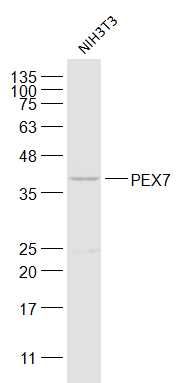Anti-PEX7抗体
产品名称: Anti-PEX7抗体
英文名称: PEX7
产品编号: YB--19913R
产品价格: null
产品产地: 中国/美国
品牌商标: Ybscience
更新时间: 2023-08-17T10:29:50
使用范围: 科研使用
上海钰博生物科技有限公司
- 联系人 : 陈环环
- 地址 : 上海市沪闵路6088号龙之梦大厦8楼806室
- 邮编 : 200612
- 所在区域 : 上海
- 电话 : 183****2235
- 传真 : 021-60514606
- 邮箱 : shybio@126.com
Anti-PEX7抗体
| 产品编号 | YB-19913R |
| 英文名称 | PEX7 |
| 中文名称 | 过氧化物酶体生成蛋白7抗体 |
| 别 名 | PBD9B; PCDP1; Peroxin 7; Peroxin-7; Peroxisomal PTS2 receptor; Peroxisomal targeting signal 2 receptor; Peroxisome biogenesis factor 7; Peroxisome targeting signal 2 receptor; PEX7; PEX7 protein; PEX7_HUMAN; PTS2 receptor; PTS2R; RCDP1; RD. |
| 规格价格 | 100ul/1380元 购买 200ul/2200元 购买 大包装/询价 |
| 说 明 书 | 100ul 200ul |
| 研究领域 | 细胞生物 神经生物学 信号转导 |
| 抗体来源 | Rabbit |
| 克隆类型 | Polyclonal |
| 交叉反应 | Human, Mouse, Rat, Dog, Pig, Cow, Horse, Rabbit, Sheep, |
| 产品应用 | WB=1:500-2000 ELISA=1:500-1000 IHC-P=1:400-800 IHC-F=1:400-800 ICC=1:100-500 IF=1:100-500 (石蜡切片需做抗原修复) not yet tested in other applications. optimal dilutions/concentrations should be determined by the end user. |
| 分 子 量 | 36kDa |
| 细胞定位 | 细胞浆 |
| 性 状 | Lyophilized or Liquid |
| 浓 度 | 1mg/ml |
| 免 疫 原 | KLH conjugated synthetic peptide derived from human PEX7:61-160/323 |
| 亚 型 | IgG |
| 纯化方法 | affinity purified by Protein A |
| 储 存 液 | 0.01M TBS(pH7.4) with 1% BSA, 0.03% Proclin300 and 50% Glycerol. |
| 保存条件 | Store at -20 °C for one year. Avoid repeated freeze/thaw cycles. The lyophilized antibody is stable at room temperature for at least one month and for greater than a year when kept at -20°C. When reconstituted in sterile pH 7.4 0.01M PBS or diluent of antibody the antibody is stable for at least two weeks at 2-4 °C. |
| PubMed | PubMed |
| 产品介绍 | background: This gene encodes the cytosolic receptor for the set of peroxisomal matrix enzymes targeted to the organelle by the peroxisome targeting signal 2 (PTS2). Defects in this gene cause peroxisome biogenesis disorders (PBDs), which are characterized by multiple defects in peroxisome function. There are at least 14 complementation groups for PBDs, with more than one phenotype being observed in cases falling into particular complementation groups. Although the clinical features of PBD patients vary, cells from all PBD patients exhibit a defect in the import of one or more classes of peroxisomal matrix proteins into the organelle. Defects in this gene have been associated with PBD complementation group 11 (PBD-CG11) disorders, rhizomelic chondrodysplasia punctata type 1 (RCDP1), and Refsum disease (RD). [provided by RefSeq, Oct 2008] Function: Binds to the N-terminal PTS2-type peroxisomal targeting signal and plays an essential role in peroxisomal protein import. Subunit: nteracts with PEX5. Subcellular Location: Peroxisome. Cytoplasm. Tissue Specificity: Ubiquitous. Highest expression in pancreas, skeletal muscle and heart. DISEASE: Defects in PEX7 are the cause of peroxisome biogenesis disorder complementation group 11 (PBD-CG11) [MIM:614879]. PBD refers to a group of peroxisomal disorders arising from a failure of protein import into the peroxisomal membrane or matrix. The PBD group is comprised of four disorders: Zellweger syndrome (ZWS), neonatal adrenoleukodystrophy (NALD), infantile Refsum disease (IRD), and classical rhizomelic chondrodysplasia punctata (RCDP). ZWS, NALD and IRD are distinct from RCDP and constitute a clinical continuum of overlapping phenotypes known as the Zellweger spectrum. The PBD group is genetically heterogeneous with at least 13 distinct genetic groups as concluded from complementation studies. Defects in PEX7 are the cause of rhizomelic chondrodysplasia punctata type 1 (RCDP1) [MIM:215100]. RCDP1 is characterized by rhizomelic shortening of femur and humerus, vertebral disorders, cataract, cutaneous lesions and severe mental retardation. Defects in PEX7 are the cause of peroxisome biogenesis disorder 9B (PBD9B) [MIM:614879]. A peroxisome biogenesis disorder with unusually mild clinical and biochemical manifestations. Affected individuals manifest a variable phenotype similar to, and in some cases indistinguishable from, classic Refsum disease. Variable features include ocular abnormalities, sensorimotor neuropathy, ichthyosis, deafness, chondrodysplasia punctata without rhizomelia or growth failure. Similarity: Belongs to the WD repeat peroxin-7 family. Contains 6 WD repeats. SWISS: O00628 Gene ID: 5191 Database links: Entrez Gene: 5191 Human Entrez Gene: 18634 Mouse Entrez Gene: 308718 Rat Omim: 601757 Human SwissProt: O00628 Human SwissProt: P97865 Mouse Unigene: 280932 Human Unigene: 338363 Mouse Important Note: This product as supplied is intended for research use only, not for use in human, therapeutic or diagnostic applications. |
| 产品图片 |
 Sample:
NIH3T3(Mouse) Cell Lysate at 30 ug Primary: Anti-PEX7 (bs-19913R) at 1/300 dilution Secondary: IRDye800CW Goat Anti-Rabbit IgG at 1/20000 dilution Predicted band size: 36 kD Observed band size: 36 kD |
